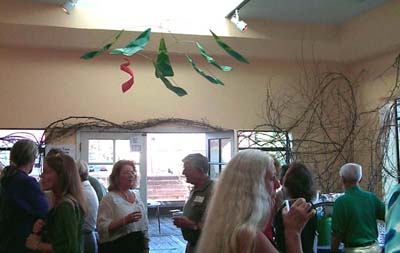Artist's Statement
At a recent art opening, I hung a large mobile, the Sunflower, at the far side of a room, just above head height, right over the serving table for drinks and hors d'oeuvres, which I thought would be the ideal location for the work to be seen. Nonetheless, most people coming into the room wouldn't see it right away -- some never saw it -- most of our tunnel-vision attention normally goes straight ahead or down. But eventually, a bit of color or movement would catch their eyes, and they would look up with wonder. The mobile was doing it's job!

Ceilings are great! When we look up, we have automatically opened ourselves, searching for something other than ordinary life. My job as an artist is to find this other world, locate desirable pathways into it, and construct objects which lead the viewer in these directions. The grace and movement of the mobile form help in this task.
E.J. Gold, a good artist and friend, said "art is an industrial occupation". This is particularly true in the line of metal sculpture I am following. I begin with metal stock from hardware stores or industrial suppliers: aluminum flashing or sheet; brass and steel wire; bronze, aluminum and stainless rod. I work primarily with simple hand tools: shears, files, pliers, cutters, punches, hammers and chisels. With these tools, I refine the materials through a series of processes: cutting and filing it the sheet to create shapes; texturing the shapes to give them volume, structure and fractalization; cutting and bending the rod and wire and attaching the surfaces to form the articulated skeleton of the mobile; balancing and tuning the mobile and adjusting the composition for shape and movement; etching, priming, airbrushing and sealing the metal to add color and light; then balancing and finishing the work.
My academic training is as a pure mathematician, so people often assume I must plan each of these works through computation. I do understand some of the physics of balance and movement, but in practice this is used in a qualitative, empirical manner -- if I add weight here, the center of mass will shift, changing the angle of the arm; if I bend the wire too much, it will become instable and want to flip over. But get it closer to the point of instability, and there will be more movement. Based on this kind of qualitative theoretical understanding, and years of experience building these mobiles, I usually begin with a rough sketch or concept -- the target size, the dynamical system, the types of shapes. But as the mobile is assembled piece by piece, bottom up, chance and inspiration modify the original design concept, sometimes leading to a very different work.
When this work is successful, it transforms essentially lifeless industrial materials into something alive, which can delight and wonder, bringing that life from my studio into the homes and businesses of my customers. In fact, many of these sculptures are what I call "metallic lifeforms" -- abstracted to various degrees from lifeforms on Earth, or sometimes what could be lifeforms, but operating under different sets of laws.
